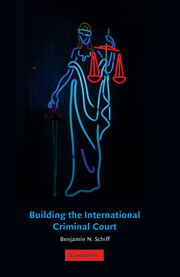Book contents
- Frontmatter
- Contents
- Preface
- Acronyms
- Building the International Criminal Court
- Introduction
- 1 River of Justice
- 2 Learning from the Yugoslavia and Rwanda Tribunals
- 3 The Statute – Justice versus Sovereignty
- 4 Building the Court
- 5 NGOs – Advocates, Assets, Critics, and Goads
- 6 ICC–State Relations
- 7 The First Situations
- 8 Conclusions: The Politics of the International Criminal Court
- Web Sites for Further and Ongoing Information
- Bibliography and Sources
- Index
3 - The Statute – Justice versus Sovereignty
Published online by Cambridge University Press: 05 September 2012
- Frontmatter
- Contents
- Preface
- Acronyms
- Building the International Criminal Court
- Introduction
- 1 River of Justice
- 2 Learning from the Yugoslavia and Rwanda Tribunals
- 3 The Statute – Justice versus Sovereignty
- 4 Building the Court
- 5 NGOs – Advocates, Assets, Critics, and Goads
- 6 ICC–State Relations
- 7 The First Situations
- 8 Conclusions: The Politics of the International Criminal Court
- Web Sites for Further and Ongoing Information
- Bibliography and Sources
- Index
Summary
The Rome Statute of the ICC reflects states' agreement over how to institutionalize a broad range of international criminal justice norms while still protecting national sovereignty. In some areas, most prominently the issue of jurisdiction, the Statute's final provisions can be characterized as a lowest common denominator outcome, keeping on board all but the states most concerned about a potential erosion of sovereignty. On other topics, such as reparations and victims' rights, the Statute represents the cutting edge of normative development. From the Court's standpoint, the Statute is broadly permissive, even quite demanding, because of the range of objectives it outlines. But the Court faces the conundrum that while charged with an immense task, it must rely upon states to support and enforce its actions. As this chapter will show, the Court's leverage is weak.
A large literature skillfully describes the negotiations and the legal fine points of the Rome Statute process. Starting with a brief chronology, then discussing the Statute's major features, this chapter uses theoretical standpoints of realist interests, the neoliberal institutionalist dynamic, and the constructivist logic to explain the outcome of the negotiations and states' attitudes toward the Court. Realist assumptions show why states might be reluctant to sign; institutionalism helps elucidate the structure of the Court and pinpoints major organizational challenges. Constructivism clarifies why states protective of their sovereignty nonetheless join the ICC.
- Type
- Chapter
- Information
- Building the International Criminal Court , pp. 68 - 101Publisher: Cambridge University PressPrint publication year: 2008
- 1
- Cited by

